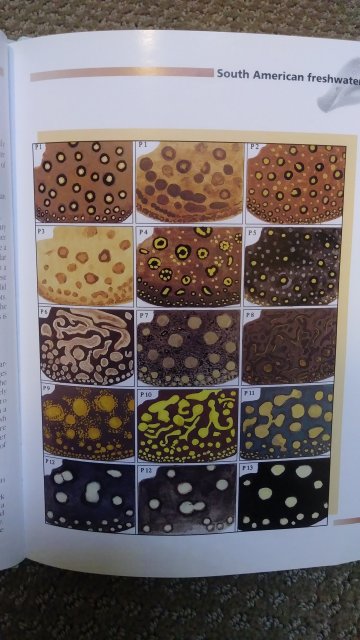As far as I know, there are otorongo, snow leopard, castexi, menchachai/tiger, and falkneri rays, all of which fall under none of the species I had listed above from the book. This gets confusing, I'll figure those out in the morning.
I'm sure there are others, too.
P-numbers go up to 62 I believe, so that might help as well. I think it's doable, but it'll take some work.
Yep many P#s aren't actually species just variants I found the full list. Although without pictures it's not all that helpful with some of the stranger morphs.
P1 – Potamotrygon Motoro
P2 – Potamotrygon sp. "Aparico"
P3 –Potamotrygon Motoro “Variant”
P4 – Potamotrygon Schroederi "Colombia"
P5 – Potamotrygon aff. Motoro
syn; Potamotrygon sp. "B"
P6 – Potamotrygon Hystrix - "Brazil"
syn; Potamotrygon sp "C"
P7 – Potamotrygon Scobina
P8 – Potamotrygon sp. “Marmor”
P9 – Potamotrygon Dumerilii
P10-Potamotrygon Humerosa
P11-Potamotrygon Orbignyi
P12-Potamotrygon Henlei
P13-Potamotrygon Leopoldi
P14-Potamotrygon sp. "Itaituba"
P15-Plesiotrygon Iwamae - “Antenna Ray”
P16-Plesiotrygon Iwamae - “Antenna Ray”
P17-Plesiotrygon sp."Blacktailed Antenna ray"
P18-Plesiotrygon sp."Blacktailed Antenna ray"
P19-Potamotrygon sp. “Mantilla”
P20-Potamotrygon sp. “Mantilla”
P21-Potamotrygon sp. “Mantilla”
P22-Potamotrygon sp. “Orange”
P23-Potamotrygon Humerosa
P24-Potamotrygon sp. “Marmor”
P25-Potamotrygon Castexi “Otorongo”
P26-Potamotrygon Castexi “Otorongo”
P27-Potamotrygon Castexi “Estrella”
P28-Potamotrygon Castexi “Otorongo”
P29-Potamotrygon Castexi “Hawaiian”
P30-Potamotrygon Castexi
P31-Potamotrygon Castexi “Tigrinus”
P32-Potamotrygon Castexi “Tigrillo”
P33-Potamotrygon Castexi "Estrella"
P34-Potamotrygon Castexi "Estrella"
P35-Potamotrygon Castexi “Otorongo”
P36-Potamotrygon Castexi “Motelo”
P37-Potamotrygon Scobina “Belem”
P38-Potamotrygon Scobina “Belem"
P39-Potamotrygon Scobina “Belem”
P40-Potamotrygon Schroederi “Peru Flower”
P41-Potamotrygon Signata
P42-Potamotrygon Dumerilii
P43-Potamotrygon sp. “Chocolate”
P44-Potamotrygon Motoro sp. “Morph”
P45-Potamotrygon Schroederi - “Sacha”
P46-Potamotrygon Humerosa - “Mosaic Ray”
P47-Potamotrygon Dumerilii - “Blume"
P48-Potamotrygon Signata
P49-Potamotrygon sp. "Tiger"
P50-Potamotrygon sp. "Tiger"
P51-Potamotrygon sp. "Tiger"
P52-Potamotrygon sp. "Tiger"
P53-Potamotrygon Falkneri
P54-Potamotrygon Castexi - “Carpet Ray”
P55-Potamotrygon cf. Yepezi
P56-Paratrygon Aiereba - "Ceja"
P57-Paratrygon Aiereba - “Manzana”
P58-Potamotrygonidae gen.sp. "China ray"
P59-Potamotrygonidae gen.sp. "Coly ray"
P60-Potamotrygon cf. Histrix sp. “Rio Negro”
P61-Potamotrygon Humerosa
P62-Potamotrygon Leopoldi "Sao Felix"
Species Variants
Potamotrygon Leopoldi -"Eclipse"
Potamotrygon Leopoldi -"Black Isle"
Potamotrygon Leopoldi -"Black Diamond"
Potamotrygon Motoro - "Marbled"
Potamotrygon Motoro - "Chain-Link"
Potamotrygon Motoro - "Triple Spot"
No P#'s
Potamotrygon sp. "Pearl"
Potamotrygon sp. "Peru"
Potamotrygon Reticulata
Potamotrygon cf. Hystrix - "Peru"
Potamotrygon Histrix - "Argentina"
Potamotrygon Yepezi - "Venezuela"
Potamotrygon cf. Yepezi - "Peru"
Potamotrygon Menchacai
Potamotrygon Ocellata
Potamotrygon Garrapa
Potamotrygon Constellata
Potamotrygon Brachyura
Potamotrygon Marinae
Potamotrygon Magdelenae
Potamotrygon Sp.aff.dumerilii
Potamotrygon Schuemacheri







